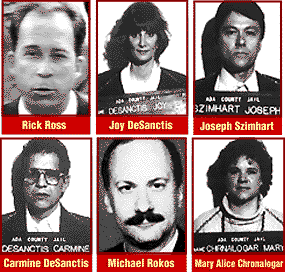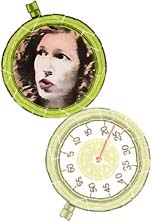
|

Tainted Motives
With overwhelming evidence at hand to disprove 60 Minutes’ conclusions about the demise of the old CAN, the question remains: Why did the program’s producers insist on taking such a one-sided approach to their story?
The answer may be found in a series of events which started in the early 1980s. At that time an attorney and a handful of clients who sought to enrich themselves by assaulting the Church through the legal system sought investors to underwrite their effort. According to the plan, those who helped to finance the lawsuits would be paid back out of the proceeds of a victory resulting in a huge damages award against the Church.
Another aspect of this plan involved enlisting media to generate negative stories about the Church and its members which would create an unfavorable climate for Scientology and help to bring about victory in the courtroom. A list of media to be enlisted in the effort, found in documents that exposed this plan, included 60 Minutes. And 60 Minutes did subsequently became an active participant in the plan, producing two segments on the Church—one in 1980, at the outset of the litigation effort, and a second in 1985.
At the time, the old Cult Awareness Network was also attempting to flank the litigation, provide witnesses for spurious cases, incite tax audits of Scientologists, and otherwise help to mount a campaign of harassment against the Church and its members. Among those who helped instigate litigation against the Church at that time was attorney Leta Schlosser.
Today, Schlosser works with California attorney Dan Leipold, who represented CAN until its demise. Among Leipold’s current clients is a Seattle woman, Stacy Young, an apostate member of the Church of Scientology. On the one hand, Young provides false or misleading testimony about Scientology for profit. On the other, she has at different times met Church officials and offered to cease making distorted statements to the press if paid half a million dollars, for example.
Not surprisingly, Young was Stahl’s primary source for almost all of the false allegations made on her program regarding the Church’s supposed efforts to bring about the demise of the old CAN.
And Leta Schlosser, who helped spearhead the litigation efforts against the Church and its members during the 1980s, is the aunt of 60 Minutes producer Richard Bonin—the man who initiated and conducted the program on CAN.
Neither 60 Minutes nor any of its producers have ever denied any of these facts, but Stahl did give an inane denial at the end of the show that the family tie had any influence on the show. And despite the evidence, including the rebukes of CAN in the courts, 60 Minutes insisted to the bitter end that they “stood by their story.”
History of Errors
Other examples abound of such 60 Minutes arrogance.
In November 1986, the program produced a story on the Audi 5000 luxury sedan which described how the accelerator pedals of new sedans would inexplicably stick, causing the cars to lurch forward, crash into walls, swimming pools, other vehicles and even innocent bystanders.
The story was later debunked by a 1989 report by the National Highway Traffic Administration (NHTSA). Automotive consultant William Rosenbluth later admitted that he had drilled a hole in an Audi transmission and piped fluid into it to provide the lurching effect. In the resulting film sequence of the tampered-with vehicle, the accelerator pedal appeared to move down on its own and provided 60 Minutes with damning visual evidence.
Audi was vindicated but not without suffering massive financial losses which brought the company to the brink of bankruptcy.
In another case from the 60 Minutes archives, early in 1997 the scenario repeated when the program charged that some hospitals, to obtain donors for organ transplants, had allowed surgeons to discontinue life support and administer harmful medication to patients who might otherwise have been kept alive.
Again, the 60 Minutes plot line bore little resemblance to the truth. Every organ donor in question was the victim of a traumatic injury, had been pronounced brain dead and withdrawn from life support at the request of their families. And these cases represented only one percent of all organ donations.
In June 1997, 60 Minutes came under fire from the Council for Exceptional Children (CEC), the largest professional association of teachers, administrators and others concerned with disabled children. CEC condemned what it called a misleading and distorted story by Leslie Stahl on the cost of special programs to educate disabled children and make them contributing members of society, rather than forcing them into institutions—a program which had represented a savings of more than $52 billion per year.
In each of these cases, 60 Minutes refused to admit any error. In December 1998 and again in April 1999, when 60 Minutes did admit it aired programs that used faked evidence, the “admission” had a twist. “[W]e were deceived,” read one CBS statement. “60 Minutes is acknowledging that it was snookered,” led off one prominent news report. Admissions conspiciously lacked discussion of what CBS could and should have done to verify its sources and materials.
Accountable to No One
At the core of this problem are those journalists and their producers and editors who continue to report as if they are responsible to no one. Few media subjects have the wherewithal to fight back effectively when forced to spar with lies, unethical reporters and the smokescreen of “respectability” used by some media to convince viewers and readers of their veracity.
Despite such barriers, the public continues to demand solutions to the problem.
One approach toward a solution is found in the advice of Senator Allan Simpson to former White House staffer Hodding Carter during a 1998 Nightline program. As the Senator stated, “My friends used to say ‘Al, when everything else fails, why not tell the truth?’”
That would also make life easier for journalists. They would not have any problem being held accountable if they reported just the truth, or if they did not know the truth, not pretending that they did—and giving a full portrayal of all sides so that the audience can make up its own mind.
But any way it is viewed, if the problem of media ethics is ever going to be solved it will have to be solved by journalists themselves forcing in more honest and ethical standards.
Brill’s Content, an investigative magazine which has established itself as a media watchdog, provided one of the best statements on how news reporters should view themselves:
“We believe that journalists should hold themselves as accountable as any of the subjects they write about. They should be eager to receive complaints about their work, to investigate complaints diligently and to correct mistakes of fact, context, and fairness prominently and clearly.”

|

|









